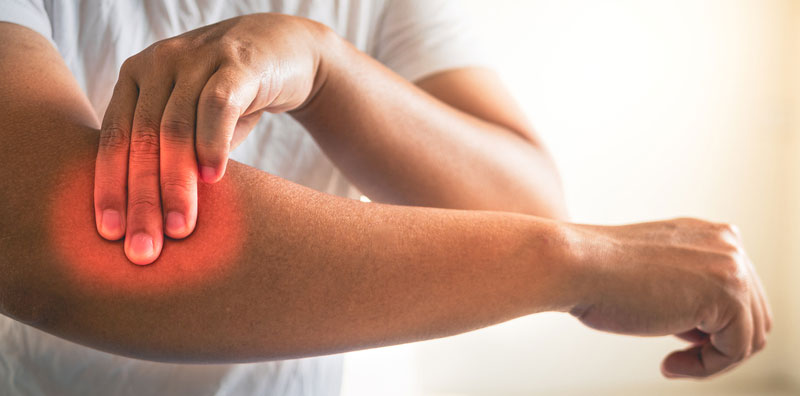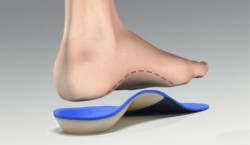Tennis Elbow Tests & Assessment Techniques
What is Tennis Elbow?
Tennis elbow, also known as lateral epicondylitis, develops when the forearm muscles connecting to the outer part of the elbow become irritated, resulting in pain and tenderness typically localized on the lateral side of the elbow. Often, individuals experience discomfort when gripping or carrying objects.
This condition frequently arises from overuse or improper technique during physical activities. Engaging in repetitive and forceful arm or wrist movements, as well as lifting heavy objects, can lead to the onset tennis elbow.

Various straightforward tests exist to assess whether one has tennis elbow. While some of these tests can be self-administered, many necessitate the involvement of a medical professional. Call our office for an assessment at 604-439-1230 or make an appointment online.
Read the subsequent sections below to discover more about tennis elbow tests and available treatment options. Presented here are some initial tests for tennis elbow that you can perform independently at your home or office.
However, it is crucial to see Dr. Kaila to determine if additional testing is needed or if there might be alternative explanations for your symptoms. Dr. Kaila can also guide you through potential treatment options. If you experience pain, tenderness, or discomfort during any of these tests, it may indicate the presence of tennis elbow.
Tennis Elbow Assessments & Tests
Conduct these tests using the arm affected by tennis elbow. If you wish to discern variations between your arms, execute each test on both sides for comparison.
1. Palpating
- Sit with your forearm extended out in front of you on a table.
- Using your other hand, gently touch the bony upper knot outside your elbow, the lateral epicondyle and the area above it.
- Slowly increase the pressure until there is pain or you determine there is no pain.
2. The coffee cup test
In this self-assessment tennis elbow test, evaluate the degree of discomfort you experience when holding a cup of coffee or a carton of milk in your hand.
3. Resistance Test: Palm and Finger
There are two types of resistance tests designed for assessing tennis elbow, focusing on either stretching or extending the wrist and forearm muscles that may be impacted.
- Extend your affected arm straight in front of you, palm facing downward, parallel to the floor.
- Place the palm of your opposite hand on the top of the extended hand. Using the bottom hand (affected arm), attempt to bend your wrist backward while applying resistance with the palm of the top hand.
This action engages the muscles responsible for flexing your wrist and attaching near your elbow.
4. Middle finger resistance
- Stretch your affected arm straight in front of you, palm facing upward.
- Employ your opposite hand to draw your middle finger backward toward your forearm.
- Simultaneously, employ your middle finger to resist this movement.
- Subsequently, rotate your palm to face downward.
5. Chair pickup test
- Prepare a light chair with a high back for this assessment.
- Extend your affected arm straight out in front of you.
- Bend your wrist, directing your fingers downward.
- Use your thumb, first finger, and middle finger to grasp the back of the chair and lift it.
- Keep your arm straight as you raise the chair.
6. Mill’s test
Do this test with a doctor.
- While seated, straighten your affected arm.
- The doctor will fully flex your wrist to bend it forward.
- Then they’ll rotate your forearm inward while examining your lateral epicondyle.
7. Cozen’s test
Do this test with Dr. Kaila. Cozen’s test is sometimes referred to as the resisted wrist extension test or the resistive tennis elbow test.
- Extend your affected arm in front of you and make a fist.
- Rotate your forearm inward and bend your wrist toward your forearm.
- The doctor will examine your lateral epicondyle while resisting the movement of your hand.
More in-depth tests
If any of the initial tests suggest the presence of tennis elbow, additional examinations may be necessary to explore potential alternative causes for your symptoms.
Dr. Kaila might recommend an X-ray to eliminate other potential sources of elbow pain, such as arthritis. In some cases, a magnetic resonance imaging (MRI) scan may be conducted to provide a more detailed examination of the anatomical structures surrounding the elbow.
If Dr. Kaila suspects a nerve-related issue contributing to your elbow pain, she may recommend electromyography (EMG) as a diagnostic test.
Treatments
Self-Management:
Managing tennis elbow at home involves crucial steps, with primary emphasis on rest and abstaining from activities requiring arm use. Gradual resumption of activity, paying attention to form, and technique evaluation during repetitive motions are essential.
Medication:
Consult with your physician if there’s a need for nonsteroidal anti-inflammatory drugs (NSAIDs) like aspirin, ibuprofen, or naproxen to alleviate pain, swelling, and inflammation. In more severe cases, your doctor might recommend different types of injections.
Other things to try:
- Herbs and Spices: Take anti-inflammatory herbs like turmeric, cayenne pepper, and ginger.
- Cold Therapy: Apply an ice pack for 15-minute intervals.
- Alternative Therapies: Talk to Dr. Kaila about cupping, acupuncture, diluted essential oils, and wearing a forearm strap or brace to reduce elbow stress.
Alternative Options:
Extracorporeal shockwave therapy, involving sound waves to stimulate healing, may be considered for severe cases. At Central Park Chiropractic, our application of shockwave therapy showcases a nearly 100% success rate in effectively treating tennis elbow.
Tennis Elbow Exercises:
Post-inflammatory phase, engage in exercises targeting the elbow, forearm, and wrist to enhance strength, flexibility, and prevent future injury.
Recovery
Recovery duration time depends on severity and adherence to the treatment plan. Modify or avoid the triggering activity and monitor symptom recurrence after resuming normal activities.
Call Central Park Chiropractic 604-439-1230
Seek medical help for severe cases with noticeable swelling. Dr. Kaila can guide exercises and ensure proper technique, using modalities like ultrasound or ice massage.
Conclusion
You can perform initial tests for tennis elbow at home and manage symptoms independently with a well-structured treatment plan. Adjust daily or athletic movements to prevent pain, continue exercises even after recovery, and talk to Dr. Kaila if symptoms persist or worsen.


